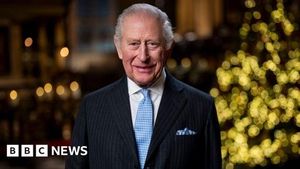In the rapidly shifting landscape of artificial intelligence and cloud computing, Oracle Corporation has found itself both in the spotlight and under scrutiny in recent months. The company, a long-time powerhouse in enterprise software and cloud infrastructure, made headlines on September 10, 2025, when its shares surged an astonishing 36% in just a single trading day. According to MoneyShow, this marked Oracle’s largest one-day jump since 1992, fueled by a reported 359% rise in remaining performance obligations—a metric that investors often interpret as a harbinger of robust future revenue.
But as quickly as Oracle’s stock soared, the euphoria faded. In a twist that has left both seasoned investors and newcomers scratching their heads, Oracle’s shares have since given back all of those hard-won gains. The pattern isn’t unique to Oracle; other major players in the AI sector, including Microsoft Corp. and Meta Platforms Inc., have also experienced similarly disappointing follow-through in their stock prices since that September surge, as MoneyShow notes. The volatility raises a host of questions about the durability of the current AI investment boom—and whether market expectations have simply run too far ahead of the underlying business fundamentals.
Behind the market drama, Oracle’s core business continues to evolve. The company’s latest earnings report, released on September 9, 2025, showed earnings per share of $1.47—just missing analysts’ consensus estimates by a penny. Revenue for the quarter reached $14.93 billion, reflecting a 12.2% increase year-over-year but still falling short of the $15.04 billion that Wall Street had forecast. Oracle’s net margin stood at a healthy 21.08%, and its return on equity was an eye-catching 72.93%. For the upcoming quarter, Oracle has set guidance in the range of $1.270 to $1.310 in earnings per share, a signal of cautious optimism amid the broader market’s nervousness.
Institutional investors have been actively reshuffling their Oracle holdings in recent quarters. According to a recent MarketBeat report, Retirement Solution LLC slashed its Oracle stake by nearly half in the second quarter of 2025, selling 1,123 shares and retaining 1,155 shares worth $253,000 at the end of the period. Other institutional investors, however, have doubled down. Brighton Jones LLC, for instance, increased its Oracle position by 189.3% in the fourth quarter of 2024, now owning 153,580 shares valued at $25,593,000. Revolve Wealth Partners LLC, New York State Common Retirement Fund, Fulton Breakefield Broenniman LLC, and Louisiana State Employees Retirement System have all reported increases in their Oracle holdings, underscoring the mixed sentiment among large investors. In total, institutional investors and hedge funds currently own 42.44% of Oracle’s outstanding shares.
Oracle’s leadership has also been active in the market. CEO Clayton M. Magouyrk sold 40,000 shares on October 21, 2025, at an average price of $276.64, reducing his ownership stake by 20.62% and netting $11,065,600. Director William G. Parrett sold 11,500 shares at $306.00 per share on September 12, 2025, trimming his position by 39.30%. In total, insiders have sold 204,254 shares worth $60,227,807 in the past three months, according to SEC filings. Despite these insider sales, 40.90% of Oracle’s stock remains in the hands of company insiders, a figure that some investors may interpret as a sign of confidence in the company’s long-term prospects.
On November 10, 2025, Oracle stock opened at $239.15, with a market capitalization of $681.77 billion. Its price-to-earnings ratio stood at 55.36, and it had a PEG ratio of 2.96, reflecting expectations of future growth. The stock’s 12-month low was $118.86, and its high reached $345.72, illustrating the wild swings that have characterized the past year. Oracle’s 50-day moving average was $279.32, while its 200-day average clocked in at $231.30, suggesting that the recent pullback has brought the stock closer to its longer-term trend line.
Amid the financial turbulence and shifting investor sentiment, Oracle continues to roll out new products and win over customers—especially in the healthcare sector. Baraga County Memorial Hospital (BCMH), a 15-bed critical access hospital in Michigan’s Baraga County, recently announced it will deploy Oracle Health CommunityWorks to enhance both clinician and patient experience. BCMH, which employs over 200 people and has used Oracle ambulatory solutions in its clinics for five years, will also expand its use of the Oracle Health Clinical AI Agent across its facilities. The goal? To integrate disparate systems, streamline clinician workflows, reduce administrative tasks, and improve patient care.
“Oracle Health understands the unique needs of critical access hospitals, and we expect that adopting a more integrated approach will help us boost operational efficiency and enhance care quality in our community,” said Rob Stowe, chief executive officer of Baraga County Memorial Hospital. “With Oracle Health CommunityWorks solutions and Clinical AI Agent, we are enhancing the clinician experience and enabling them to make more informed decisions regarding patient care.”
The hospital will also adopt Oracle Health Seamless Exchange, a tool designed to aggregate, cleanse, and normalize patient data from external sources into a single, unified patient record. This technology aims to replace manual information-sharing steps with a streamlined digital process, freeing up clinicians to spend more time with patients and less time on paperwork. Seema Verma, executive vice president and general manager of Oracle Health and Life Sciences, emphasized Oracle’s commitment to rural healthcare: “Oracle is committed to empowering rural hospitals with innovative, AI-powered solutions that streamline operations and expand access to quality care. We’re teaming with BCMH to equip them with a more unified system that reduces the administrative burden on caregivers and helps care teams access the right information at the right time to optimize patient care.”
Oracle’s efforts in healthcare are part of a broader push to tailor its cloud and AI offerings to the unique needs of smaller health systems and critical access hospitals. Oracle Health CommunityWorks, for example, is specifically designed to address the clinical, financial, and operational challenges faced by rural providers, blending digital infrastructure, seamless interoperability, and virtual care capabilities. The company brings nearly two decades of experience working with rural healthcare organizations, giving it a deep understanding of the sector’s transformative opportunities and challenges.
Despite the ups and downs on Wall Street, analysts remain cautiously optimistic about Oracle’s future. According to MarketBeat, the company currently enjoys a consensus rating of “Moderate Buy,” with an average price target of $323.69. Some analysts, such as those at Stifel Nicolaus, have set even higher price targets, while a handful have issued “Sell” ratings, reflecting the diversity of opinion in the market. Oracle’s recent quarterly dividend of $0.50 per share, paid on October 23, 2025, represents an annualized yield of 0.8% and a payout ratio of 46.30%—a sign that the company remains committed to returning value to shareholders even as it invests heavily in innovation and growth.
As Oracle navigates the choppy waters of the modern tech market, its ability to deliver on the promise of AI and cloud computing—while meeting the real-world needs of customers like Baraga County Memorial Hospital—may prove to be the ultimate test of its staying power.





